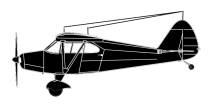
ASN Wikibase Occurrence # 357312
This information is added by users of ASN. Neither ASN nor the Flight Safety Foundation are responsible for the completeness or correctness of this information.
If you feel this information is incomplete or incorrect, you can submit corrected information.
| Date: | Saturday 1 June 1996 |
| Time: | 13:30 LT |
| Type: |  Piper PA-20 |
| Owner/operator: | Private |
| Registration: | N1645A |
| MSN: | 20-843 |
| Year of manufacture: | 1952 |
| Total airframe hrs: | 2300 hours |
| Engine model: | Lycoming O-320 |
| Fatalities: | Fatalities: 0 / Occupants: 1 |
| Aircraft damage: | Substantial |
| Category: | Accident |
| Location: | Pasco, WA -
 United States of America United States of America
|
| Phase: | Landing |
| Nature: | Training |
| Departure airport: | (KPSC) |
| Investigating agency: | NTSB |
| Confidence Rating: |
The student pilot, who was flying solo at the time of the accident, reported that during the landing roll, the aircraft's left wing dropped and that he was unable to counter this wing drop with aileron. He stated that the tailwheel-equipped aircraft began a 'sweeping [right-hand] turn' at this point. He indicated on a sketch of the accident sequence that a 'L.H. tire skid mark' began at the point where the uncontrollable wing drop occurred, curving to the right until its termination point on the runway pavement, where he stated he believed the gear collapsed. The aircraft came to rest on the right shoulder of the runway. FAA Advisory Circular 61-21A, Flight Training Handbook, states that pilots of tailwheel aircraft must be especially vigilant for directional control problems during the after-landing roll since the aircraft's center of gravity is behind the main wheels, and notes that ailerons and rudder become less effective as the airplane slows during the landing roll. The pilot reported that he had 87.4 total pilot hours including 33.8 hours in type, 16.4 solo hours in type, and 45.8 hours of tailwheel aircraft time; and had received his solo and tailwheel endorsements within the previous 2 1/2 months.
Probable Cause: the pilot's failure to maintain directional control of the airplane during the landing roll, which resulted in an inadvertent ground swerve and collapse of the left main gear.
Accident investigation:
 |
|
Sources:
NTSB SEA96LA107
Location
Revision history:
| Date/time | Contributor | Updates |
|---|---|---|
| 13-Mar-2024 16:29 | ASN Update Bot | Added |
Corrections or additions? ... Edit this accident description
The Aviation Safety Network is an exclusive service provided by:


 ©2024 Flight Safety Foundation
©2024 Flight Safety Foundation